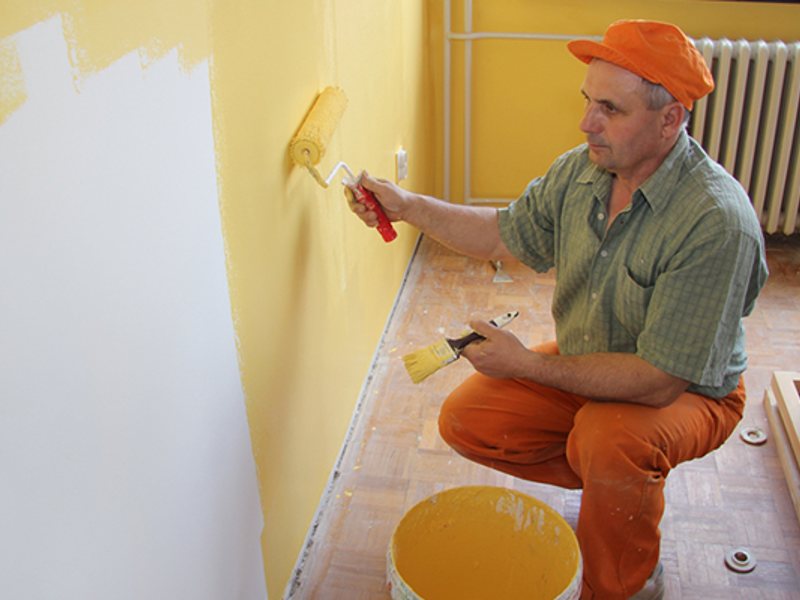Interior Paint vs. Exterior Paint: What’s the Difference?
Paint plays a vital role in beautifying your home, or any building for that matter. However, choosing the right type of paint is even more important to fulfil its purpose. While all paints are similar, not all are ideal for painting your home's exterior and interior. Paints differ in the components they are made of. It's their chemical composition that determines their application.
Often, homeowners get stuck on a common question, whether it is ideal to use exterior paint for interiors. Are exterior and interiors paint interchangeable? While the straightforward answer to this question is NO, the blog reflects on the deeper aspects of this.
So, let’s learn more about the type of paint, interior paint vs. exterior paint, and when to use each.
Types of Paints
There are broadly two categories for paint: water-based (also acrylic or latex paint) and oil-based paints. Nearly a decade ago, oil-based paints were used on exterior surfaces because of their affordability and durability.
However, oil-based paints have been proven harmful to the environment and human health. For this reason, such paints have been restricted in their use. Although, these can be used in small amounts in some situations.
This led to the widespread use of water-based paint for both interior and exterior house painting. Such paints have better adhesion and coverage. Water-based paints also boast many benefits, including minimal odour, shorter drying time, ease of cleaning, and inflammability.
Further, water-based paints release significantly lesser volatile organic compounds (VOCs) during drying. They are also resistant to yellowing and fading if protected from sunlight.
Primary Paint Ingredients
The primary composition of both interior and exterior paint is the same. Both of these contain resins, pigments, additives, and solvents. Each of these ingredients has a different role to play.
- Understanding the roles played by each of these ingredients can help you choose the right paint type for any interior paint vs. exterior paint project.
- Pigments are tiny particles that give the paint its colour. There are two types of pigments, namely prime and extender. Prime pigments, also known as colourants, provide the paint's actual colour. Organic pigments, on the other hand, produce bright colours. Inorganic pigments are earthy and more durable, making them ideal for exterior use.
- Resins are responsible for binding the pigments together to form the paint film. Oil-based resins are derived from oils like linseed oil. They are a critical ingredient affecting the performance characteristics of the paint directly.
- Additives offer different properties to paints, including levelling agents, thickening agents, emulsifiers, biocides, and surfactants. These properties aid in colour accuracy, better adhesion, improve the application, and prevent mildew growth.
- Solvent liquids enable the ingredients in paint to be applied to surfaces. Water is the primary solvent in water-based paints, while oil-based paints require paint thinner made from various solvents like acetone, turpentine, naphtha, mineral spirits, and others.
Key Differences Between Interior & Exterior Paint
- Interior Paint vs. Exterior Paint - The Basics
So, what is exterior paint? It is a specially formulated paint designed to withstand harsh outdoor environmental conditions. It is typically made with high-quality resins and pigments that resist fading, chalking, cracking, and peeling.
In addition, exterior paint usually contains additives that protect against UV rays, moisture, and mildew.
On the other hand, interior paint is a type of paint formulated for interior house painting. It is typically made with lower volatile organic compound (VOCs) levels to reduce indoor air pollution.
Interior paint also comes in a wide range of colours and finishes to match any décor and can be easily cleaned with soap and water.
- Interior Paint vs. Exterior Paint - Composition & Its Impact
Interior paint contains rigid resins, facilitating easy cleaning and making them stain-resistant. Vinyl acrylic resins are commonly incorporated into interior paints, enhancing their washability and resistance to further scrubbing.
Contrary to this, exterior paints utilise softer resins that offer properties to combat fading, mildew, moisture, and temperature changes. To resist chipping and peeling, exterior paint requires a more robust composition. Hence, most house painting Melbourne painters prefer 100% acrylic resins or optimal outcomes.
Further, acrylic resins provide superior adhesion and alkali resistance, ensuring the paint does not peel over fresh concrete or masonry.
The additives present in paints regulate drying time, improve weather resistance, and ensure even pigment distribution. Interior paints are not equipped with certain additives necessary for exterior application. This makes them unsuitable for use on exterior surfaces.
- Interior Paint vs. Exterior Paint - Varied Needs
Naturally, exterior and interior paints are subjected to different environmental conditions. Exterior paint must withstand cold winds, storms, hail, and the sun's intense heat during summer.
In contrast, interior paint is not exposed to such harsh conditions. Imperfections in interior paint are more visible and unappealing, requiring easy cleaning and maintenance. Thus, different requirements apply to each type of paint.
- Interior Paint vs. Exterior Paint - Toxicity Level
One crucial difference between interior and exterior paint is their toxicity. Interior paint is typically formulated to minimise the amount of VOCs released during application. These toxins can be harmful to human health. Since interior paint is used in living spaces, they must be low in VOCs.
On the other hand, exterior paints focus on durability since exposure to VOCs is less of a concern as they are used outdoors.
- Interior Paint vs. Exterior Paint - Finishing Options
Interior paints come in many finishes, including eggshells, matte, semi-gloss and gloss, satin, and many types of faux-finish effects.
Exterior paint offers comparatively lesser finish options. Typically, it’s available only in flat, gloss or semi-gloss enamel.
When To Use Each Paint Type?
There is no valid justification for using interior paint outdoors or exterior paint indoors because these paints are specifically formulated for use on different surfaces and in different environments. In fact, using exterior paint products indoors can pose health hazards, while at best, the resins in exterior paint make it unsuitable for interior surfaces.
On the other hand, using interior paint on exterior surfaces will result in a brief lifespan as it is not designed to endure temperature variations and UV rays. Furthermore, due to the presence of inflexible resins, it will fracture and flake under extreme hot or cold weather instead of expanding and contracting accordingly.
Can Exterior Paint Be Used For Interiors?
The simple answer is NO. Although exterior paints are formulated to be tough and withstand harsh conditions, they are prone to scuffing and scratching. This is very noticeable if it happens on interior surfaces.
In addition, exterior paints release more VOCs into the air, which can be dangerous when used indoors. Conversely, using interior paint outdoors can result in peeling and cracking due to temperature changes. It is always best to use the appropriate paint for the job to achieve the best and longest-lasting results.
The Final Say
In conclusion, interior and exterior paints are specifically formulated for their respective environments and have distinct differences in terms of their chemical composition and performance characteristics. It is important to choose the appropriate paint for the job to ensure the best long-lasting result.
House painting is a challenging job as well as a huge investment. Hence, you must consult a trustworthy house painting Melbourne contractors to help you choose the right paint for your home, environment and your health.












Add Your Comments
comments powered by Disqus